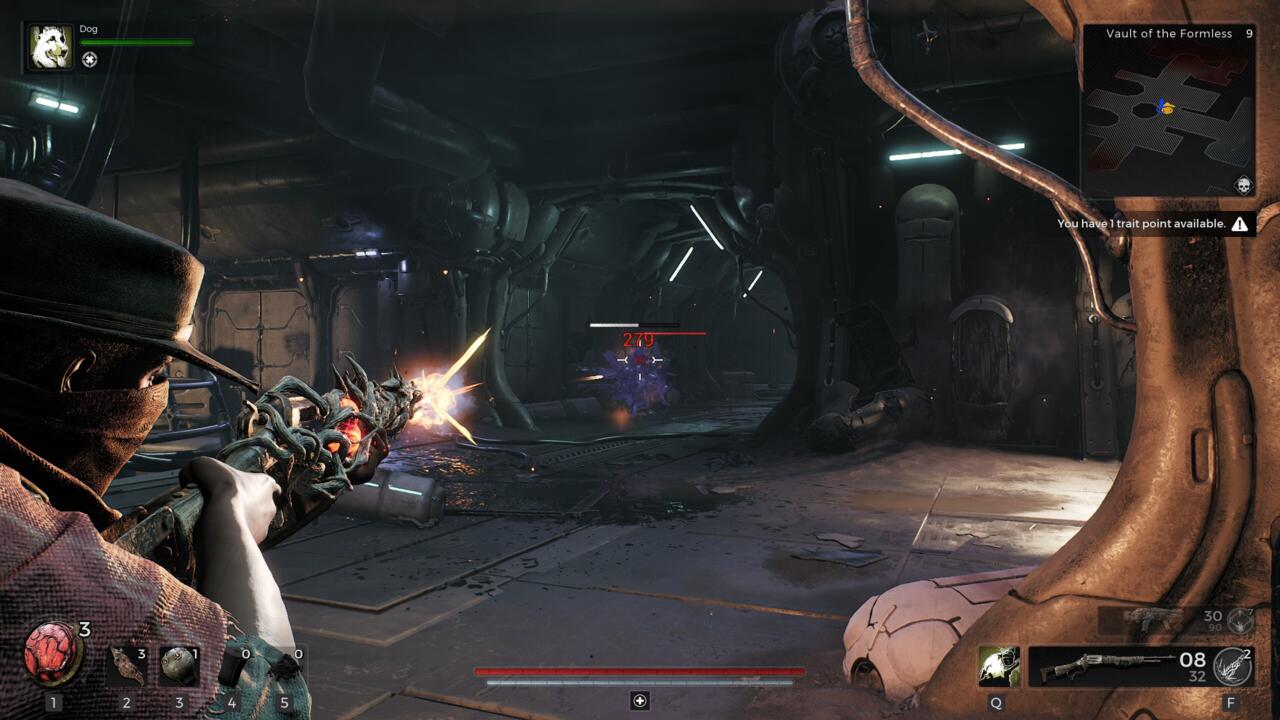Remnant 2 is the kind of sequel that improves upon its predecessor in almost every facet. The third-person gunplay has been tightened up and refined, there’s more color and variety to its diverse locales, and the various RPG elements and character progression have been greatly expanded upon, giving you more options to construct a unique build along with the incentive to delve into the game’s near-limitless replayability. “Dark Souls with guns” was used as shorthand to describe Remnant: From the Ashes, and although that label wasn’t wrong, it also wasn’t representative of the full picture. The first game stood out amongst a bevy of other Souls-likes because of the ways it deviated from the formula, and Remnant 2 continues to build on those foundations with a more dynamic and robust action-adventure that only falters in a couple of areas.
The first game wasn’t without its flaws, either, an underbaked story chief among them. Unfortunately, Remnant 2 doesn’t fare much better in this regard, offering another forgettable tale that lacks personality and engaging stakes, almost to the point where it feels like a copy and paste of the original game. Even the setup is essentially the same, beginning on the dilapidated streets of a post-apocalyptic Earth that’s been ravaged by an interdimensional being known as The Root. You eventually arrive at a small settlement called Ward 13–the same hub area as the first game, albeit in a slightly different spot–and despite being an injured newcomer, your custom character is immediately entrusted with a crucial task that quickly leads to a mission that decides the fate of all realms.
Contrivances aside, it’s difficult to care about the overarching story when the world as you know it consists of roughly a dozen people who might as well be cardboard cutouts. Characters such as McCabe and Rigs return, but they’re one-note vendors like before, while the friend you arrived with and risked your life to save performs the same static role. There are more interesting characters found in the various realms you’ll visit throughout the game; however, the game’s procedurally generated structure ensures that it takes a few playthroughs to form a clear picture of the lore and composition of each world, and by that point you’ll have probably forgotten everything you learned previously, such as the abundance of abstract concepts verbally thrown your way. The ending’s emotional payoff lands flat as a result.
These narrative failings are one of the few areas where Remnant 2’s procedural generation actively works against it, because its ambitious implementation is otherwise excellent. Much like the first game, the layout of each realm and the dungeons therein are randomly generated with every playthrough. Enemy placement, meanwhile, changes whenever you return to a location, reload after death, or rest at a checkpoint. These procedurally generated combat scenarios add an element of unpredictability to each enemy encounter that isn’t found in other Souls-likes and ratchets up the tension, but Remnant 2 also takes things a step further by dynamically generating almost every aspect of your adventure. Boss fights, side quests, the NPCs you’ll meet, and even the opening tutorial all differ from player to player and from one playthrough to another. My first venture in the realm of Losomn, for example, saw me take a grimy trek through the ankle-high waters of a repugnant sewer, yet upon returning in the game’s Adventure Mode–which I’ll get to soon–I happened upon a derelict sanatorium instead. This creepy, run-down facility featured its own distinct storyline, characters, unique weapons, and sequence of shootouts and boss fights, and this degree of variation and unpredictability is crucial because you’re encouraged to revisit areas in order to supplement Remnant 2’s reworked buildcrafting.
Upon arriving in Ward 13, you’re asked to pick from a selection of distinct Archetypes. These classes are similar to those found in Remnant: From the Ashes, with your choice dictating your starting weapons and armor. This time around, however, each Archetype also has a number of perks and skills associated with it, which unlock as you level up. These are based on your chosen Archetype’s role, whether you’re a Medic, a class like the Hunter that focuses on ranged damage and marking enemies, or the Challenger and its close-range proficiency. I opted for the Handler purely because it gives you a canine companion to fight beside. There’s just something about battling monstrous hordes in tandem with man’s best friend that makes perfect sense. Aside from kiting damage and attacking enemies, one of my dog’s perks allowed them to revive me if I was downed, while others would increase stats like damage and movement speed when we were near one another. Each Archetype can also equip one of three unique skills that are governed by a cooldown meter, typically enhancing one of your classes’ specialized abilities.
While Archetypes were an afterthought in the previous game, these changes to how they work in the sequel make your initial selection an important one, placing Remnant 2 more in line with other class-based shooters. Once you’ve picked a class, however, you’re not locked into that decision for the rest of the game. You can discover each of the other Archetypes while playing, though doing so is easier said than done–I only found two during my playthrough. That said, I could swap out my initial selection for either one at any time. Once you’ve reached the max level of 10 on a particular Archetype, however, you can then equip dual Archetypes, thus unlocking double the perks and skills. This is where Remnant 2’s buildcrafting comes into its own, letting you mix and max disparate Archetypes to create some interesting amalgamations. Whether you’re merging a DPS class with a support type or combining the long-range perks of the Hunter with the short-range aptitude of the Challenger, there are some fun concoctions to be made.

Gallery
Outside of this, you can also equip a plethora of rings, amulets, and mods to further strengthen your build. These mods can be applied to weapons to create alternate fire modes, such as letting you unleash a helix of missiles that divide into smaller rockets on impact, or surprising enemies by launching an egg that cracks open to reveal a horde of angry space crabs. You can’t attain all of these mods and trinkets in a single playthrough, but rather than starting the campaign over again, you can simply hop into Adventure mode. This is essentially a shortened version of the campaign, giving you the chance to replay a single realm if you want to search for unique drops or see all of the different permutations of bosses, areas, and so on, without starting from scratch. It’s an ingenious way of extending the game’s lifespan while also letting you upgrade your character without grinding well-trodden ground.
It helps that Remnant 2’s no-nonsense combat is much improved over the first game. Movement is responsive to the point where it never feels like you’re fighting the controls in order to evade danger. The assortment of weapons on offer is generally fun to use, too, each packing a satisfying punch as you send lead coursing through bulky robots and slithery tree monsters. It’s the sort of game that gets better the longer you play, as your build comes into focus and you begin to hone in on your preferences and unlock some of the more creative boss weapons. Combat isn’t outstanding in any one area, but it’s rewarding enough, and the core gameplay loop quickly digs in its hooks to the point that it becomes difficult to put down. The only time this feeling dissipates is during your journey through the final realm, when a lack of respite leads to frustration. Rather than focusing on challenging combat puzzles, these final few battles are more like acts of attrition as you’re constantly swarmed by mobs of enemies. On numerous occasions, I was revived by my dog only to die before being able to move again. It’s a difficulty spike that feels cheap and unearned, especially since Remnant 2 rectifies a similar issue the first game suffered from where boss fights were regularly saddled with too many mobs.
The realms you’re sent to explore are at least more visually arresting this time around, featuring a broader color palette than the frequent browns and greys of the first game. The clash of art styles sometimes feels a little slapdash, but the concept of these divergent realms means there doesn’t necessarily need to be a cohesive throughline. One moment you’ll be traversing a gaudy castle adorned in gold and decorated with opulent statues, while an hour or so later you might be blasting rifle-toting villagers as the game indulges its From Software comparisons by whisking you off to a Yharnam-adjacent town. It’s not just the visuals that have improved either. The addition of more verticality ensures that enemies can appear from almost anywhere, while the size of each area has expanded, making long-range weapons like sniper rifles more viable.
Remnant 2 is exactly what you want from a sequel, such is the way it expands and improves upon the first game’s ideas. It’s not likely to blow you away, but the core gameplay loop–built on rewarding combat, an ever-expanding repertoire of skills and abilities, and the randomness of its procedural generation–latches on and refuses to let go. The final realm is disappointing because of an artificial difficulty spike, and the story is still lackluster and easy to ignore, but those looking for a solid and malleable shooter won’t go far wrong with Remnant 2.
























